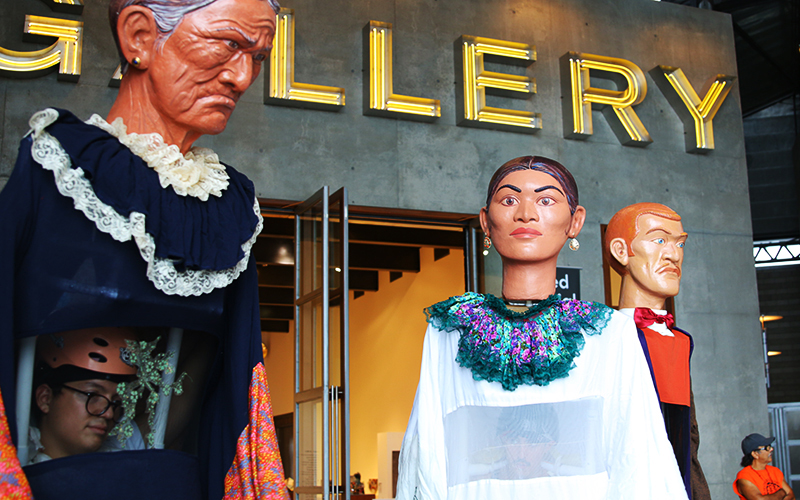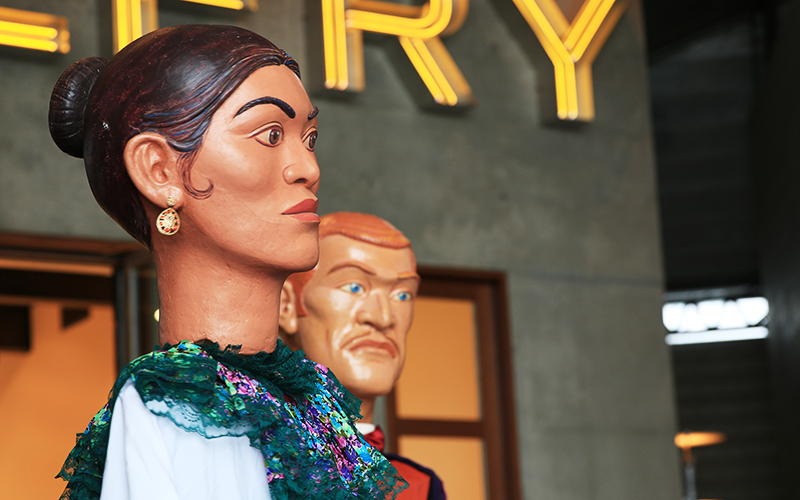
Andy Gonzalez (left) and Eli Renteria (right) operate large puppets for an excerpt of Borderlands Theater’s Barrio Stories at the Oct. 2, 2016, El Puente Festival in the Tempe Center for the Arts. (Photo by Andres Guerra Luz/Cronkite News)
TEMPE – Four giant puppets towered over the stage.
Their smooth faces were made of foam and painted into frozen expressions of anger, sadness, dignity and seduction. They wore brightly colored Mexican-themed costumes. They scolded and smooth-talked and shouted as they told the story of the demolished Latino neighborhood La Calle that once stood in downtown Tucson.
They’re part of a puppet show that resembles a morality play, touching on the themes of survival in the face of loss of identity at the hands of a dominant culture.
“It’s been happening for a very long time,” said Andy Gonzalez, an associate producer for the Tucson-based Borderlands Theater, which recently put on the show at the El Puente Festival at the Tempe Center for the Arts.
“As you modernize,” he said, “things change and sometimes they get forgotten. And it’s important to remind everybody of that.”
The puppets were created by Zarco Guerrero, a Phoenix artist who is the art director and founder of the Phoenix-based Cultural Coalition, which partnered with Childsplay to put on the festival.
The puppets are the grand finale to a series of one-act plays called Barrio Stories, performed by the Borderlands Theater. The plays tell the story of the destruction of a Latino neighborhood that was replaced by the Tucson Convention Center in 1968.
The series was originally performed in Tucson, where three plays about 15 minutes long would be produced simultaneously. The puppets traveled to Tempe to entertain an enthusiastic crowd of about 500 people recently at the El Puente Festival.
“It is a great story and a story that needs to be told,” said Anthony Runfola, the general manager at Childsplay that partnered with Cultural Coalition to put on the El Puente Festival.
Runfola, who said he had lived in Tucson for five years, didn’t know about the history of La Calle until he heard about the plays, and even though the story is based off events in Tucson, “we have very similar stories in the Phoenix area as well.”
Guerrero, the artist who created the puppets and is known for his mask-making, said carving the foam heads took about three months.

La Calle (left) and El Guapo (right) puppets speak of loss and temptation during the Borderlands Theater’s Barrio Stories performance on Oct. 2, 2016, at the El Puente Festival in the Tempe Center for the Arts. (Photo by Andres Guerra Luz/Cronkite News)
The plays, which were produced in Tucson this spring, were performed three times so audience members could rotate between each play, said Gonzalez, the associate producer for the plays. In the intervals between plays, members from the community would act out small scenes that served as “memory fragments” of the old neighborhood, he said.
Gonzalez said from 500 to 1,000 people would attend the plays in Tucson and became part of it, immersing themselves in these memory fragments.
He said the plays were based off Lydia Otero’s book La Calle and interviews with former neighborhood residents. True local stories helped give audiences a sense of the city in a time when the barrio thrived.
Gonzalez said the replacement of La Calle with the Tucson Convention Center was like taking out “the heart of that city” and putting in its place this “giant foreign object” that lacked life.
He said the process of building the convention center involved the government gradually buying homes from all the people who had lived in the neighborhood for generations and pushing those people out to the surrounding areas.
This resulted in decades of failed businesses and lack of growth to the area where the culturally thriving neighborhood once stood, he said.
Glenn Grabski, the general manager of the Tucson Convention Center, said the center brings in about 500,000 people to downtown Tucson each year. And one of the attractions for tourists this year was Barrio Stories, which were performed at the convention center in the spring.
“I thought it was a wonderful event,” Grabski said.
Gonzalez said the plays also pull from folk tales, which helped people relate to the stories of La Calle.
“There was a sense of responsibility,” Gonzalez said, “to make sure these stories from the past are continued to be told.”
“Once la gente–the people–were gone, there was no life,” he said.